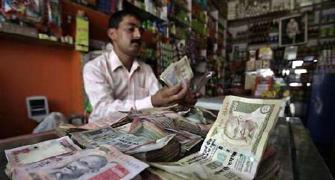 Stung by the rupee's recent collapse, Reserve Bank of India is taking a carrot-and-stick approach to curb trade in the offshore forwards market that is seen as a key source of wrenching currency volatility.
Stung by the rupee's recent collapse, Reserve Bank of India is taking a carrot-and-stick approach to curb trade in the offshore forwards market that is seen as a key source of wrenching currency volatility.
However, with no viable alternative to trading in non-deliverable forwards involving the rupee, the strategy is likely to have only a limited impact.
The RBI recently met with a handful of foreign banks and asked them to stop acting as market-makers for rupee NDFs, according to three bankers involved in the discussions.
At the same time, it has held out the promise of easing restrictions to allow greater participation in the onshore forex market by overseas participants.
"They are saying that if you are a big pension fund or a large hedge fund, come to India and we will provide you with all the dollar liquidity that you need rather than going to the NDF markets," said the head of trading at a US bank in Hong Kong, who did not want to be named.
Still, those promises have remained largely unfulfilled, and faced with an economy growing at a decade-low speed and a yawning current account deficit, traders have often turned to the offshore market to bet against the rupee.
While Indian regulations forbid offshore rupee trading by local entities, the rules are easily skirted.
For example, a company with overseas operations can take opposing rupee positions on and offshore -- the latter beyond the purview of the RBI but perfectly legal overseas.
Global funds cannot rebook a forward contract onshore once cancelled, and foreigners are not allowed to trade in local currency futures despite a promise in February to let them in.
New RBI chief Raghuram Rajan, who took office Sept 4, said the bank will look to ease restrictions once the rupee stabilises.
"We have to make sure that we provide deep and functioning markets so there is no need to establish a parallel market outside," he said last week, without providing specifics.
Bearish rupee bets
The offshore market in the partially convertible rupee has flourished, with average daily trading volumes rising to about $5 billion a day earlier this year from a few hundred million dollars in 2006, traders say.
That puts the offshore trade on par with India's restrictive onshore market, where daily spot volumes are around $5-$6 billion.
Bearish bets on the rupee in offshore markets have been cited by traders as a key cause of the rupee's recent harrowing plunge, when it slumped to a series of record lows, losing as much as 20 per cent in 2013 to 68.85 to a dollar in late August.
It has recovered 11 per cent since then, helped by the central bank's move to attract more inflows and the US Federal Reserve's decision to hold back on tapering its extraordinary stimulus.
During the depths of the rupee's weakness, the 1-month NDF was an unusually wide 2.5 per cent weaker than the onshore spot rate, as overseas investors bet heavily against the currency.
In one of many efforts to crack down on such arbitrage, the RBI in July imposed higher margin limits for banks trading in the onshore exchange-traded currency futures market.
Offshore rupee volumes have fallen by roughly half since then, some traders said, while the rupee has also stabilised somewhat.
Volumes in other emerging market NDFs have also fallen amid recent emerging market weakness.
India's restrictions have come at a cost, reducing local trading liquidity and making it more expensive for companies such as oil refiners that have heavy forex requirements.
"We do not have a 24-hour market and money is fungible," said Abhishek Goenka, chief executive at India Forex Advisors, a forex consulting firm.
"NDF volumes won't fall a lot."
(Additional reporting by Sumeet Chatterjee in Mumbai)









